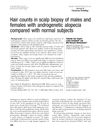TLDR Aptamin C® enhances vitamin C's antioxidant effects, benefiting skin by reducing oxidative stress and inflammation.
The study investigated the effects of Aptamin C®, a DNA aptamer designed to enhance the antioxidant efficacy of vitamin C by preventing its oxidation. Vitamin C is known for its role in collagen synthesis and as a major antioxidant, but its effectiveness is often reduced due to oxidation. The research included both in vitro and clinical tests, which demonstrated that the Aptamin C® and vitamin C complex effectively scavenged reactive oxygen species (ROS) and exhibited anti-inflammatory properties, suggesting its potential benefits for human skin.
 30 citations
,
July 2017 in “BioEssays”
30 citations
,
July 2017 in “BioEssays” Activating NRF2 might help treat hair disorders by improving antioxidant defenses.
 13 citations
,
March 2017 in “PubMed”
13 citations
,
March 2017 in “PubMed” People with a common type of hair loss have higher stress levels in their body, and treatments that reduce this stress could help.
19 citations
,
December 2011 in “PubMed” Inflammation and immunity play a key role in androgenetic alopecia, with better treatment outcomes in certain immune-positive cases.
 40 citations
,
June 2009 in “Journal of Cutaneous Pathology”
40 citations
,
June 2009 in “Journal of Cutaneous Pathology” AGA patients have fewer hairs and smaller follicles; T:V ratio above 4:1 may indicate AGA.
 39 citations
,
June 2019 in “Toxins”
39 citations
,
June 2019 in “Toxins” Bee venom might be a good alternative treatment for various skin conditions because it has many healing properties.
 15 citations
,
January 2016 in “Biological & Pharmaceutical Bulletin”
15 citations
,
January 2016 in “Biological & Pharmaceutical Bulletin” Bee venom helps hair grow and may work better than some common treatments.
 August 2025 in “Journal of Pure and Applied Microbiology”
August 2025 in “Journal of Pure and Applied Microbiology” Bee venom shows promise for treating cancer, infections, inflammation, and hair loss.
 1 citations
,
January 2024
1 citations
,
January 2024 CaBP1 and CaBP2 are necessary for proper hearing and neurotransmission in the ear's inner hair cells.

CaBP1 and 2 are important for maintaining the activity of calcium channels necessary for hearing in inner ear cells.







